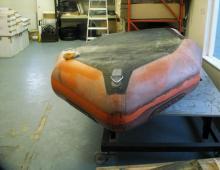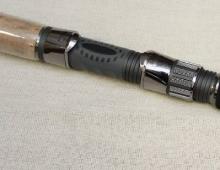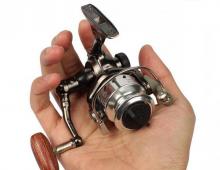Winter monster or ice fishing for rotan
Many anglers treat this Far Eastern "migrant" with contempt, but it turned out to be very tasty both in the ear and fried. Cutlets from this fish are especially tasty. And catching rotan from ice is truly exciting and catchy.

Especially when it’s not small pencils that land on your hook, but solid “firebrands” of 200 grams. For lovers of winter rotan fishing, as well as those who have never caught this visiting guest in winter, our article is addressed, written solely on the basis of our own years of experience.
Where to fish

Catching rotan in winter is possible only in fairly large water bodies, such as:
- flood ponds along river banks;
- reservoirs formed by dams on rivers.
Rotan is also found in stagnant water bodies, but fishing in winter in them is unstable and the fish caught is not large in size.
It should be noted that a reservoir that worked perfectly for rotan last season may not give the expected result this year. Most caught in ponds with the presence of perch or pike, which thin out its numbers, and small individuals rarely approach the bait.

As for the search for rotan in a pond, the following rule works: the more holes, the better the catch. The Far Eastern goby is less than other fish attached to uneven terrain or some kind of snags. Often he generally stands on a relatively flat bottom, guarding the territory. Any object that appears in its field of vision is considered by a predator as food or danger. Therefore, he either pecks, or tries to push the uninvited guest out of his territory, and, thus, is hooked.
However, it should be noted that on the first ice, rotan should be sought closer to the coast, at depths from half a meter to one and a half. Closer to the New Year, he moves deep into the reservoir at a level of one to three meters.
Often rotan pecks at half water, where you can catch it, especially on windy days with low pressure. In frosty and sunny weather, firebrands stay closer to the bottom in a deep place.
In mid-January, the biting of this fish stops until the first March thaws.
What to catch

In terms of nutrition, rotan is a typical meat eater; he practically does not consume vegetarian food. The main food objects of firebrands in the reservoir are:
- mollusks, which he swallows along with the shell;
- worms;
- insect larvae;
- fry, both fish of another species, and their own.
Based on his food preferences, winter fishing for rotan is carried out on baits such as:
- lung of birds and animals;
- liver;
- chicken skin;
- chicken intestines;
- verkhoplavka live and cut;
- worms;
- fish cutting, including rotan itself;
- unsalted fat.
The choice of such baits is determined by the characteristics of the equipment. For example, the lung is very cool on the hook and bleeds well, attracting fish. In addition, rotan often swallows a piece of bait tightly with its brush teeth and is taken out of the water without a serif on a hook, just hanging on a piece of meat.
What to catch

For catching rotan, it is used with three types of equipment:
- Lure - for catching rotan using a small lure as a mormyshka.
- Zhivtsovka - for top-flying fishing.
- Combined - combines both equipment.
lure
This tackle is an ordinary winter fishing rod with a reel. It is equipped with a large, bright nod and a small, often homemade, spinner a couple of centimeters long.
Zhivtsovka
The equipment of this fishing rod resembles a zherlichnaya, only a little more elegant. A fishing line of 0.18 millimeters is wound on a fishing rod with a reel and a nod and a plastic stopper is installed on it. Then mount a micro-olive of 2-4 grams and put the bottom stopper. At the end of the fishing line, a hook No. 8-10 with a long forearm is tied.
Combined

On this fishing rod, in addition to the spinner, they tie a leash with a hook for live bait. A twitching fry transmits vibrations to a lure with a bait, which attracts rotan twice as well.
Gear elements
- Udilnik. It is best to use a model with a handle and legs-stands. This tackle is mainly, except for the running lure, stationary.
- The nod should be soft for smooth play and clearly visible from a distance. Springs with a plastic orange or red ball are ideal in every respect.
- The fishing line, as already mentioned, should have a thickness of about 0.16 millimeters.
- Spinner necessarily with a large hook for ease of extraction from the rotan mouth. The dimensions of the spinner are about half a centimeter wide, up to three in length.
Tactics and technique
Tactically, fishing for rattan is based on the fact that if there is a fish under the hole, it will immediately respond to the proposed treat. Therefore, upon arrival at the reservoir, several holes are drilled from the shore to the depth at intervals of a meter and a half. It is better to drill them in two rows with a partner.
In shallow water, it is advisable to darken the holes with snow or specially prepared plastic or plywood covers, but the rotan, like the perch, is not afraid of the noise from the ice drill.
If there is a perch or pike in the reservoir, then it is absolutely necessary to use covers for holes with installed live bait. Otherwise, you can easily lose your tackle, which the predator can easily drag under the ice.
Then live bait and fishing rods with lure or combined gear are placed alternately in these holes. We alternately go through the holes, playing along with the fishing rods.

Separately, you need to have one running rod with a lure, which is worth constantly checking empty holes that are not occupied by other fishing rods. But by the end of fishing, their number is growing exponentially, especially on thin first ice.
Around the hole with a bite, we drill 2-3 more holes and rearrange the fishing rods there from non-cool places.
Large, over 200 grams, rotan is a loner. Rarely from one hole you can pull out 2-3 copies in a row. But after some time, the bite may repeat, so be sure to mark the catchy place.
If the principle of operation of live bait tackle is understandable and does not require any additional game, then working with a lure requires some skill. Basically it works like this:
- We lower the spinner to the bottom and knock on it several times.
- We raise the baubles by 5-15 centimeters, constantly playing along.
- We pause and make a short smooth wave and return to the place.
- We do several swings with a small amplitude.
- If necessary, repeat the cycle or do the same in another horizon of water.

The bite of the rotan pleases the angler with its confidence, and since he swallows the bait very deeply, you should not hesitate with hooking. If you hook right away, you can catch and pull out the firebrand right on a piece of lung or fat.
Lure
Basically, rotan is caught without feeding, but closer to deaf winter, when the biting subsides, they use ice bait, which is prepared and works as follows:
- At a plastic bottle, the bottom is cut off up to five centimeters high.
- Finely chopped pieces of bait are placed in the cut blank or blood is poured.
- Add heavy small pebbles.
- Fill to the top with water and freeze.
- Store ice bait in the freezer.
- When fishing, ices are lowered into the hole, thanks to the stone load, they sink well.
- Dissolving in water, ice pieces release bait pieces that float up and attract rotan.
In extreme cases, you can feed the fishing point with soil with the addition of a feed bloodworm or chopped worm.




